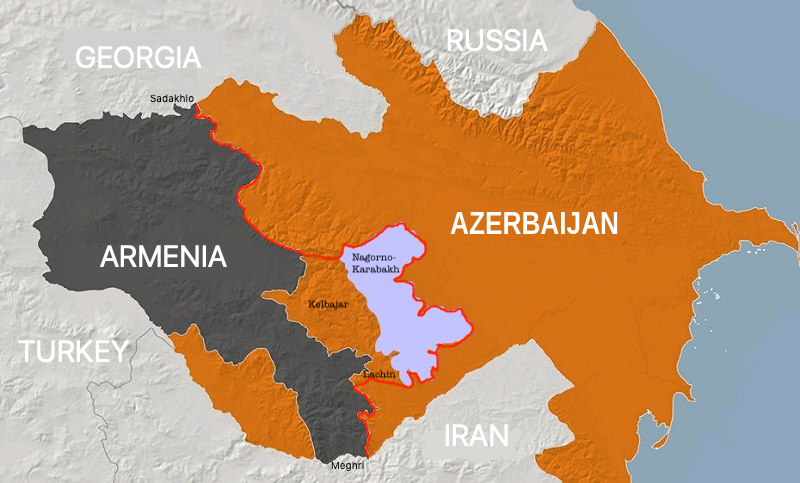The following fictional Red Cell scenario is intended to stimulate alternative thinking and challenge conventional wisdom, tying together events in operational fiction with national realities.
Four years of planning culminated in an artificial intelligence (AI) simulation of an operation without precedent that any of us knew. The best data we have was from our group’s previous operation. Operation Terter was a psychological operation used to understand the depth of Azerbaijani hatred against Armenians. Hundreds of Azerbaijani military and associated individuals were eventually arrested, with many tortured to death. It was consequential that with just a little critical thinking on the part of the Azerbaijani military and security services, it would have been evident that no Armenians dressed up in Azerbaijani uniforms had entered the town of Terter. All it took was to pay off a group of Azerbaijani soldiers to hang out in small groups and speak to each other while throwing in a few well-known Armenian words. It was amazing what rumor, innuendo, and a mechanism to get back at fellow Azerbaijanis feuding over who pilfered what military equipment can accomplish. We could have failed catastrophically, considering many of us were neither local to Armenia nor Nagorno-Karabakh. Operation Terter demonstrated that the hatred of Armenians ran so deep in Azerbaijan that the Azerbaijanis would torture each other to death on the mere illusion of collusion with Armenians. No wonder Azerbaijanis in the fall of 2020 and later in the fall of 2022, beheaded, hacked up, and shot to death unarmed Armenian POWs while mutilating female Armenian soldiers, then proudly smeared their handiwork across the internet. We planned to use this national ethos in the cognitive manipulation of Azerbaijani society.
It was necessary to keep the Armenian government in the dark about Operation Terter since, for sure, some Armenian officials would have notified Baku for no other reason than expecting a monetary reward or other favors. Dollars know no nationality!
The Operation
Our AI guys were able to impress some local university Big Data research psychologists with the results of our Operation Terter — with cleansed data. That was in 2017. Today, the results of that data, the planning, the simulations, and the contacts in Armenia, Azerbaijan, a few in Iran, and others in Georgia, would cement the role of the Armenian diaspora in Armenia, not unlike European Jews in Israel. One of the most significant logistical challenges was establishing a shadow diplomatic corps.
The operation was based on these assumptions:
1 – The Azerbaijani ethos, where the more one hates Armenians, the more one qualifies as an Azerbaijani.
2 – Armenians will follow any demonstrated leader.
3 – All oligarchs protect their wealth, and national borders are considered arbitrary.
4 – Many people in the region believe rumors and have no training in critical thinking.
5 – Although Turkey would be amid civil unrest leading to the mid-June 2023 elections, it must not look like Azerbaijan is under some threat. Instead, the events planned must look like a societal reaction. Our final operation was timed to coincide with the height of civil violence in Turkey.
The Azerbaijanis had to believe they were taking advantage of greedy Armenians. The Armenian oligarchs had to think they were taking advantage of naive diaspora Armenians. Our group of mainly diaspora-led Armenians had to:
1 – Orchestrate conditions for the self-exodus of the Armenian government.
2 – Install a new government with distributed governance.
3 – Keep civil operations and infrastructure running.
4 – Scare the average citizen and force them to stay in their homes.
5 – Use direct and alternate widespread media to spread what appears to be credible rumors.
A fictitious paper trail started as far back as 2018 for a charity known as the Karabakh Relief Fund (KRF) that claimed to have collected $245,000,000. The financial goal of this effort was to reach $500,000,000. Years of fake news made this charitable effort well-known in Armenia and Azerbaijan. As conditions changed with Armenia’s Prime Minster Nikol Pashinyan so-called ‘Velvet Revolution’ and the massive losses in the 2020 Karabakh War, it was time to execute the plan. The KRF committee came across in interviews and videos as simple-minded Armenian nationalists. This act was part of the illusion. This fund appeared to be ripe for graft by the existing and up-and-coming Armenian oligarchs, most of whom were in the government. This was demonstrated when $150,000 was purposely spent on repaving a village road in Armenia near Nagorno-Karabakh – twice – while the actual cost of such a project was not more than $30,000. The KRF happily accepted all the excuses of those in the Armenian Parliament involved in asphalt procurement and road construction. For the oligarchs, this felt like the 1990s, with corrupt officials ripping off entire sections of Armenian infrastructure. Finally, the KRF announced its most ambitious project, the rehabilitation of what remained of Armenian Nagorno-Karabakh. This folly caught the attention of the Azerbaijani oligarchs, who were awarded jurisdiction over vast areas of this conquered territory from the Armenians, most of whom were friends and extended family members of the Azerbaijan-ruling Aliyev dynasty. The political timing of this operation was essential. It would coincide with massive nationwide protests against the abysmally-run rescue operations and shoddy construction in the aftermath of the catastrophic February 2023 earthquakes that devastated south-central Turkey. These protests became election violence, and civil disturbances built before Turkey’s June 2023 general elections.
The KRF had little difficulty seeking out Armenian oligarchs from the bottom of the gold-plated barrel. The KRF group was met at Yerevan’s Zvartnots airport by Armenia’s oligarchic luminaries with their top-of-the-line German automobiles, with drivers doubling as bodyguards. Police escorts whisked them away to five-star hotels owned by these same oligarchs, where they were given the best suites. Of course, the following day, the KRF people requested to see Mt. Ararat, the Catholicosate of Ejmiatzin, the Garni Temple and the Geghart Church Complex, and the Yereblur military cemetery, typical of first-time arrivals in Armenia.
Through intermediaries in Tbilisi, Georgia, meetings were arranged between Armenian oligarchs and Azerbaijanis overseeing their newly acquired lands. One of our representatives, Hayduk, in Tbilisi knew Russian and Azerbaijani and told us how well these ‘otherwise arch enemy’ oligarchs got along, having much more in common than either side would admit. Hayduk claimed only to know English and Western Armenian. While much of the discussions were in Russian, the Azerbaijanis would mutter in Azerbaijani between themselves. Hayduk’s translator was only translating items here and there from Russian, yet Hayduk followed everything with a poker face.
These oligarchs devised an elaborate plan to drain the KRF’s funds slowly and with deliberate bureaucracy. The operation was proceeding close to our simulations. While in Tbilisi, we contacted local experts with years of experience creating sexual kompromat used against selected political figures – a common occurrence in Georgia. It also turns out these experts have additional expertise in producing the highest quality simulated ‘human interaction’ along these lines. This capability proved vital for the success of this operation. One of these Georgians worked with Jeffrey Epstein on Little St. James Island, so we knew we had the best.
We discovered that the Azerbaijanis had nasty kompromat on Pashinyan, his wife Anna, and many other figures in the Armenian government. The Azerbaijanis obtained this kompromat directly from Armenians for a hefty quarter million dollars and much more from Azerbaijani contacts in the Israeli Mossad. Pashinyan knew of this kompromat, and Baku steered Pashinyan politically in ways that now made sense. Pashinyan was informed of the KRF plans, and he immediately told Baku. Aliyev thanked Pashinyan, but the former didn’t act upon this knowledge in the ways one might have expected.
Unfortunately, to divert some attention from this scheme, mid-level officials in both Baku and Yerevan initiated minor skirmishes between their opposing armies. There were scores wounded on both sides, some seriously. The KRF wasn’t expecting this to happen, although it came up in the AI simulations after including Bayesian enhancements. The KRF was patronizingly assured that this fighting was not significant and that because of KRF’s efforts, such battles were insignificant as ‘confidence building’ was already taking place between Armenia and Azerbaijan. The Armenian oligarchs requested they control the funding transfers between the KRF and subcontractors in Nagorno-Karabakh as some in Baku would immediately become suspicious of non-Armenian citizens involved in ‘benefiting the lives and future’ of the remaining Armenians of Nagorno-Karabakh. The KRF was told that Baku appreciated their efforts. In addition, the KRF was told that activities must stay under the radar to benefit ‘both our peoples.’ The Armenian oligarchs were told that KRF funds had to be transferred in small amounts per the fund’s contract with the EU bank. This arrangement kept the one-way money value barely covering costs while ensuring a large amount would never be available for theft.
Armenian security services and other unnamed international agencies were tracking every public step in this KRF scheme, some hoping to cash in personally. Specific Armenian ministries were kept updated, including the prime minister. This security investigation was beginning to appear as a turf issue between competing interests as security services requested extra pay or other forms of compensation (protection money) for tolerating the scheme. The schism forming was beneficial, and fortunately, all local parties took the diasporan Armenians as simple idiots.
Traunches promised the Azerbaijanis were consistently late, as were funds destined for Armenian oligarchs. Armenians and Azerbaijanis had to front more of the funding for basic activities promised in and around Stepanakert, the capital of Nagorno-Karabakh. Armenia and Azerbaijan sent investigative agents to the United States, France, and a few South American countries to verify that the KRF was legitimate. The actions of these investigative agents were closely monitored by the KRF, with real and fake kompromat created by the Georgian team on these investigators. It’s always good to have unused kompromat than none when circumstances demand otherwise!
The social media AI bot technicians were processing the mounting kompromat. Our AI guys learned a lot from their Georgian counterparts. Rumors were spreading in Stepanakert that reconstruction of some sort was beginning. Still, it wasn’t clear who was initiating it, as neither Armenians were admitting they were behind it, nor were the Azerbaijanis obstructing it. This situation was anticipated, but little could be done about these rumors other than their publication in the Armenian press. The Azerbaijani state-controlled press was silent, but these rumors were being posted on Armenian-run-Russian-language-fake-Azerbaijani-Telegram channels along with videos of Azerbaijani atrocities committed against Armenians to enhance their believability. Aliyev’s internal security apparatus followed these events, even though the KRF funds involved were trivial compared with the windfall money destined to be laundered from EU states needing supposed Russian-free gas supplied by Azerbaijan.
There was continued suspicion in Azerbaijan about who would ultimately be ‘granted’ jurisdiction of captured Armenian territories with transition metals (copper, molybdenum, gold, etc.) mines. Currently, they are run by Azerbaijani and British interests. The KRF representatives in Armenia were being monitored and followed, yet they still pretended to be naïve tourists. They knew their communications would be monitored and acted accordingly, but things had to move forward quickly, as planned.
The Sting
 Genuine Azerbaijani Telegram channels were hot with controversy as news spread of a joint Armenian-Azerbaijani ‘something’ going on in Nagorno-Karabakh. Azerbaijan thought it best to mention this rumor in the official Azerbaijani state press as the basis for either future deniability or accountability as circumstances warranted. As the KRF teams passed through Iranian customs at Meghri, Armenia – on another tour, of course – the first wave of sex videos was released by our Georgian experts but looked as if they were posted from an Israeli internet address, temporarily providing third-party credibility.
Genuine Azerbaijani Telegram channels were hot with controversy as news spread of a joint Armenian-Azerbaijani ‘something’ going on in Nagorno-Karabakh. Azerbaijan thought it best to mention this rumor in the official Azerbaijani state press as the basis for either future deniability or accountability as circumstances warranted. As the KRF teams passed through Iranian customs at Meghri, Armenia – on another tour, of course – the first wave of sex videos was released by our Georgian experts but looked as if they were posted from an Israeli internet address, temporarily providing third-party credibility.
Frankly, they were wild videos of specific Armenian and Azerbaijani oligarchs together enjoying hired escorts, but the worst were the ‘manufactured’ ones with the underaged. Also released were videos of these same Azerbaijanis and Armenians at various venues in Moscow and other large European capitals. It was one thing living with rumors of oligarchs with second wives or Russian models, but another when hours of kompromat were surreptitiously published from Israel. Immediately, the ambassadors from Israel and Azerbaijan were called for an explanation from their respective host countries. Our social media bots began publishing covertly-dumped KRF-sourced documents, some real and some fake, describing the close cooperation between Armenian and Azerbaijani lower-level oligarchs with the tacit approval of the Armenian government. Lists of those wounded in the contrived battles between Armenian and Azerbaijani soldiers were published, as well as fake deaths on the Azerbaijani side. Images and videos of fake Count Dracula-like atrocities inflicted upon Azerbaijani soldiers enraged the Azerbaijani population.
Even though there was chaos in Yerevan, it was much worse in Baku. Azerbaijanis were in the streets, furious at Azerbaijanis working with Armenians. Higher-level government officials with direct ties with Azerbaijani President Aliyev were outraged but read as the “The lady doth protest too much.” The sex videos and other documents were a monumental public embarrassment to the post-Soviet Azerbaijani national ethos. Aliyev tolerated the growing protests throughout Azerbaijan but soon understood his error and brought out the interior ministry troops to quell the protests. Our social media bots relentlessly pumped their channels with fake documents showing there had always been this level of cooperation between Armenia and Azerbaijan. For decades Turkey objected to any such collaboration, which is one reason why Ankara finally took control of the Azerbaijani military in the late summer of 2020.
Baku immediately released the kompromat it had on Pashinyan, his family, and other Armenian government officials. In Armenia, we witnessed the typical lame protests calling the government traitors, but on June 1, at 3:30 am, a series of massive blasts woke Yerevan residents from their political stupor. The Armenian parliament building was destroyed by what appeared to be either a rocket or some other high explosive. It turns out it was both. A drone designed to carry a heavy load but not stay airborne long dropped a custom thermobaric explosive on the parliament building, triggering pre-planted high explosives. Windows were shattered in buildings and apartments for nearly a kilometer in radius. Most of the metal fence around the parliament complex was destroyed. Explosions occurred at the Ministry of Defense facility near Jrvezh, at the homes of dozens of oligarchs and scores of oligarch-owned buildings under construction across Yerevan. The main runways at Yerevan’s Zvartnots and Gyumri’s airports were made unusable by scores of low-impact guided munitions. One guided munition almost hit the mid-morning flight to Athens.
With Armenia’s main airports unusable, government officials, including the Armenian President, Prime Minister, and the vast majority of members of parliament, were escaping by helicopter or in private bullet-proof cars to either Georgia or Iran. Most wealthy and politically influential families had fled. Those with business connections in Turkey were out of luck since that country was rocked by post-earthquake election rioting and a violent backlash from Jihadists, who Erdogan sold out after signing an agreement with Syria’s Assad. Armenia’s officials and others were videoed escaping. The videos were plastered across the internet. The mobile phone systems in Armenia were hacked, and all cell phone users woke up to videos of the country in chaos, kompromat videos, and an escaping government. The military was frozen in place as there was nobody to give orders, as half of its high-ranking officers used their connections and had already left Armenia.
Months before the KRF operation, hundreds of diasporan Armenian military officers, ex-diplomats and governance experts, judges, lawyers, economists, and an array of technical bureaucrats had entered Armenia. These individuals took over positions vacated by the escaping Armenian government. It was a coup d’état using the mechanics of cognitive warfare with minimum deaths. It was unclear who was led this coup, but it didn’t make any difference. It will make a difference when genuine elections are called with a distributed worldwide Armenian governance mechanism established. The Armenian constitution was updated to reflect a federal republic with strict checks and balances. Discussions with the Kremlin were requested minutes before the first explosion was heard in Yerevan, but Putin was only woken after the explosions. Putin attempted to order the shutdown of the Metsamor nuclear station, but the phone calls were answered in Armenian, French, and English. Discussions continue with Moscow considering Gazprom shut off gas to Armenia.

Azerbaijan had not seen this much mayhem since the fall of the Soviet Union. Aliyev is firmly in power, but the population seriously questions their national ethos. Azerbaijan appears socio politically frozen. The remaining Armenians in Nagorno-Karabakh have taken over all the newly constructed roads connecting Stepanakert with Armenia proper. Armenia ordered Azerbaijani soldiers to stand down in Kelbajar as a massive electromagnetic pulse destroyed all military and civil communications in that region. This action temporarily disrupted communications in Nagorno-Karabakh. Knowing beforehand of this action, we protected vital infrastructure. Twelve hundred Azerbaijani soldiers were taken as prisoners. Every Armenian embassy, with new diplomats, has published maps of Armenia’s new eastern border, including much of Nagorno-Karabakh and connecting territory with Armenia. (See the attached map with the eastern border in red.) As we read this, border towers that see each other are being built with an electrified fence infrastructure from Sadakhlu at the Georgia border to Meghri at the Iranian border. The call has gone out for all Armenian experts worldwide to participate in the new Armenia with its distributed governance. The rumor that Armenian soldiers control the fate of Baku-Tbilisi-Ceyhan pipeline at undisclosed locations in Georgia is true.
Yerevan, Armenia
Author: David Davidian (Lecturer at the American University of Armenia. He has spent over a decade in technical intelligence analysis at major high technology firms. He resides in Yerevan, Armenia).
Link to article



